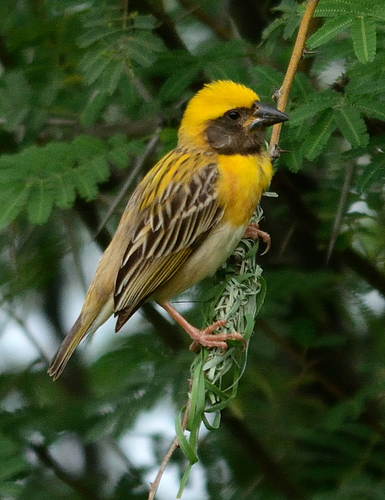
Baya Weaver
The Baya Weaver (*Ploceus philippinus*) is a small, sparrow-like bird renowned for its intricately woven nests, often found hanging from trees in colonies. These birds play a vital role in their ecosystems, primarily as seed dispersers. They hold cultural significance in many parts of South and Southeast Asia, often symbolizing skill, industry, and communal living. Their remarkable nest-building abilities have fascinated both scientists and laypersons for centuries.
13-15 cm
Length
20-23 cm
Wingspan
Least Concern
Conservation Status
Distribution
The Baya Weaver is widely distributed across the Indian subcontinent and Southeast Asia, including countries like India, Pakistan, Nepal, Bangladesh, Sri Lanka, Myanmar, Thailand, Laos, Vietnam, Malaysia, and Indonesia. They are found in lowlands and up to altitudes of around 1500 meters.
Lifespan
Around 4-6 years in the wild.
Baya Weaver's Habitat
Habitat Types
Grasslands, Scrublands, Cultivated areas, Wetlands (near reed beds), Open woodlands
Climate Zones
Tropical, Subtropical
Adaptations
Baya Weavers are highly adaptable to various open habitats, often favoring areas near water sources and with abundant grass for nest-building. Their strong beaks are well-suited for stripping grass blades and manipulating nesting materials.
Variations
Several subspecies are recognized, differing slightly in plumage and distribution. For example, *P. p. philippinus* is found in much of India, while *P. p. burmanicus* is found in Myanmar and parts of Thailand.
Appearance
Breeding Plumage
Breeding males have a bright yellow crown, dark brown mask, blackish-brown bill, and streaked upperparts. Non-breeding males and females are duller, resembling female house sparrows with streaked brown upperparts and buff underparts.
Seasonal Feather Changes
Males molt into their breeding plumage before the monsoon season and revert to a duller non-breeding plumage after.
Sex Based Plumage Differences
Significant during the breeding season; males are much more brightly colored.
Notable Features
Conical, strong bill, Bright yellow crown (breeding males), Dark facial mask (breeding males)
Diet and Feeding
Primary Foods
Seeds (grasses, grains), Insects (especially during breeding season), Rice, Nectar (occasionally)
Foraging Behavior
Baya Weavers primarily forage on the ground in flocks, hopping and pecking at seeds. They also glean insects from vegetation. They are often seen near agricultural fields, feeding on cultivated grains.
Specializations
Their strong, conical bill is adapted for cracking seeds and husking grains.
Seasonal Diet Variations
Their diet shifts to include more insects during the breeding season to provide protein for growing chicks. They rely more heavily on seeds and grains during the non-breeding season.
Behavior
Social Structure
Highly social; forms large flocks outside the breeding season and breeds in colonies. Males are often polygynous.
Communication
Chirping calls, Chattering calls in flocks, Wing flapping during courtship displays
Migration
Generally resident, but some populations may undertake local movements in response to food availability or rainfall.
Territorial or Group Behaviors
Males defend their nesting sites vigorously against other males. The colony structure provides some protection against predators.
Conservation
Threats
Habitat loss (due to agriculture and urbanization), Pesticide use (affecting food sources), Nest destruction (by humans or other animals)
Protection Programs
None specifically targeted at Baya Weavers, but general habitat conservation efforts benefit them.
Local National Laws
Protected under wildlife laws in many countries within their range, prohibiting hunting or nest destruction.
Population Trend
Stable
Population Estimates
Widespread and common; global population not precisely quantified but believed to be large.
Interesting Facts
Baya Weaver nests are architectural marvels.
The intricate weaving and knotting techniques used by males are highly specialized and passed down through generations.
Males often decorate their nests.
They may add mud pellets, flower petals, or other materials to the nest, possibly to attract females or strengthen the structure.
Baya Weavers are sometimes kept as pets, though this practice is illegal in many areas.
They were prized in some regions for their perceived intelligence and nest-building skills.
Baya weaver colonies can contain dozens of nests.
Nests are often built in close proximity, attached to branches of thorny trees or palms, offering collective protection.
Faqs about Baya Weaver
What is the purpose of the long entrance tube in the Baya Weaver's nest?
The entrance tube is believed to deter predators, such as snakes, from accessing the eggs and chicks.
Do female Baya Weavers help build the nest?
Females primarily choose the nest and may add some lining, but the majority of the construction is done by the male.
Why are Baya Weavers called 'weavers'?
They are called weavers because of their remarkable ability to weave intricate nests using grass and other plant fibers.
Are Baya Weavers endangered?
No, Baya Weavers are classified as 'Least Concern' by the IUCN, meaning they are not currently facing a high risk of extinction.
Copyright @ Nature Style Limited. All Rights Reserved.
 English
English